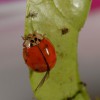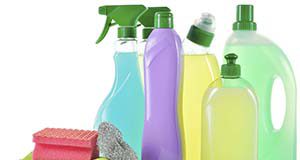Some products that we use in our homes contain chemicals that are hazardous or toxic. We can reduce the potential for exposure to chemicals from household products and produce less hazardous household waste by using alternatives that are relatively free of toxic effects. This six-page fact sheet describes some alternatives that are relatively free of toxic effects. Written by Marie Hammer, Chris Koehler, and Randall Cantrell and published by the Department of Family, Youth and Community Sciences.
http://edis.ifas.ufl.edu/he791
Tag: Environmentally Friendly Living
Natural Products for Managing Landscape and Garden Pests in Florida
 This publication describes “natural” pesticides: alternatives that are usually less toxic to non-target organisms and the environment and that, when used correctly, can be effective substitutes for synthetic products. In this publication, natural substances used for pest management in landscapes and gardens are grouped into oils, plant extracts, insecticidal soaps, mineral insecticides, microbial insecticides, and products that control diseases. Certain products contain combinations of these groups (e.g., soap and oil). This 8-page fact sheet was written by Eileen A. Buss and Sydney G. Park Brown, and published by the UF Department of Entomology and Nematology, April 2014.
This publication describes “natural” pesticides: alternatives that are usually less toxic to non-target organisms and the environment and that, when used correctly, can be effective substitutes for synthetic products. In this publication, natural substances used for pest management in landscapes and gardens are grouped into oils, plant extracts, insecticidal soaps, mineral insecticides, microbial insecticides, and products that control diseases. Certain products contain combinations of these groups (e.g., soap and oil). This 8-page fact sheet was written by Eileen A. Buss and Sydney G. Park Brown, and published by the UF Department of Entomology and Nematology, April 2014.
http://edis.ifas.ufl.edu/in197
Conserving Urban Wildlife in the Face of Climate Change
 Virtually all climatologists agree that humans are increasing the rate of the Earth’s warming by releasing greenhouse gases into the atmosphere. But you might be surprised to learn that houses and residential neighborhoods are sources greenhouse gases of carbon because everything in a house that runs on electricity or gas is often derived from burning fossil fuels. This 4-page fact sheet describes the connections between climate change, wildlife, and human neighborhoods and presents several ways for residents to live more sustainably. Written by Daniel Feinberg and Mark Hostetler, and published by the UF Department of Wildlife Ecology and Conservation, September 2013.
Virtually all climatologists agree that humans are increasing the rate of the Earth’s warming by releasing greenhouse gases into the atmosphere. But you might be surprised to learn that houses and residential neighborhoods are sources greenhouse gases of carbon because everything in a house that runs on electricity or gas is often derived from burning fossil fuels. This 4-page fact sheet describes the connections between climate change, wildlife, and human neighborhoods and presents several ways for residents to live more sustainably. Written by Daniel Feinberg and Mark Hostetler, and published by the UF Department of Wildlife Ecology and Conservation, September 2013.
http://edis.ifas.ufl.edu/uw381
Enviroshopping for Teens (FCS8756/FY342)
 Every day, we make choices that impact our environment. This 3-page fact sheet will help you make environmentally friendly choices whenever you make purchases and encourage you to take a second look at items before throwing them away. Written by Linda B. Bobroff and R. Elaine Turner, and published by the UF Department of Family Youth and Community Sciences, September 2012.
Every day, we make choices that impact our environment. This 3-page fact sheet will help you make environmentally friendly choices whenever you make purchases and encourage you to take a second look at items before throwing them away. Written by Linda B. Bobroff and R. Elaine Turner, and published by the UF Department of Family Youth and Community Sciences, September 2012.
http://edis.ifas.ufl.edu/fy342
Differences between Green Homebuilders and Traditional Homebuilders (FCS3308/FY1285)
 Homebuilders are not a homogeneous group. Throughout the majority of the US homebuilding history, homebuilders may have used similar practices and building materials, but homebuilders who build to a “green” standard differ from those who do not. This 3-page fact sheet was written by Randall A. Cantrell, and published by the UF Department of Family Youth and Community Sciences, March 2012.
Homebuilders are not a homogeneous group. Throughout the majority of the US homebuilding history, homebuilders may have used similar practices and building materials, but homebuilders who build to a “green” standard differ from those who do not. This 3-page fact sheet was written by Randall A. Cantrell, and published by the UF Department of Family Youth and Community Sciences, March 2012.
http://edis.ifas.ufl.edu/fy1285
Cleaning and Sanitizing the Kitchen: Using Inexpensive Household Food-Safe Products (FCS8OH2010/FY1280)
Consumers can protect themselves by preventing the spread of germs by both cleaning and sanitizing surfaces where food is prepared. This 3-page fact sheet provides instructions for sanitizing with bleach, vinegar, or hydrogen peroxide; and how to purchase “green” sanitizing products. Written by Janet Buffer, Lydia Medeiros, Mary Schroeder, Patricia Kendall, Jeff LeJeune, and John Sofos; adapted by Amy Simonne for use in Florida with permission, and published by the UF Department of Family Youth and Community Sciences, February 2012.
http://edis.ifas.ufl.edu/fy1280
Conservation Easements: Options for Preserving Current Land Uses (SSFOR21/FR149)
Many landowners have a strong connection to their land and want to ensure its protection for many generations. Conservation easements can prevent future residential and commercial development of one’s land, and reduce inheritance tax liability for one’s heirs. This 6-page fact sheet will describe conservation easements, what is involved in establishing one, some of the tax implications of such agreements, the government and non-government organizations that commonly participate in conservation easements, and important considerations for landowners before entering into such an agreement. Written by Chris Demers and Douglas R. Carter, and published by the UF School of Forest Resources and Conservation, March 2011.
http://edis.ifas.ufl.edu/fr149
